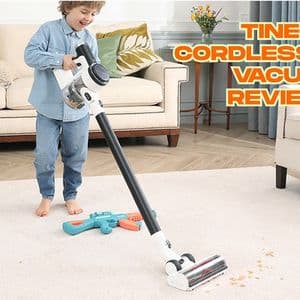Why Stick Vacuums Work Well for Hardwood Surfaces
Hardwood floors are sensitive to abrasion and moisture, which makes vacuum selection crucial. Stick vacuums, known for their lightweight build and maneuverability, are often favored for daily use on these surfaces.
Unlike heavy upright vacuums, stick vacuums reduce the risk of scuffing or denting floors. Many come with soft roller heads or brushless settings designed for hard floors, ensuring dirt removal without surface damage.
But why are they becoming so popular? Let’s dig deeper.
Understanding Hardwood Floor Cleaning Requirements
Before using any vacuum on hardwood flooring, it’s essential to understand what the surface needs:
-
Avoid scratching: Bristles can leave micro-abrasions if too stiff.
-
Prevent water exposure: Some vacuums with wet features are not suitable for wood.
-
Pick up fine dust: Hardwood tends to highlight even small amounts of dust and pet hair.
Using a vacuum that caters specifically to these factors is the key to long-term maintenance.
How to Choose the Right Stick Vacuum for Hardwood Floors
Not all stick vacuums are created equal. While many perform well on carpets, hardwood requires specific features for optimal results. Consider the following:
Suction Control
A variable suction level allows you to reduce airflow when needed. Too much suction can cause debris to scatter or even lift floorboards slightly.
Soft Roller or Brush-Off Mode
Some models include a soft roller designed to trap particles without damaging the wood. Others offer a brush-off mode to avoid spinning bristles altogether.
Rubberized Wheels
Wheels made of hard plastic may scratch the floor during repetitive movement. Look for designs that use rubber or silicone wheels to provide smoother navigation.
Lightweight Build
Weight matters. A heavy vacuum could cause dents if dropped. Lightweight stick vacuums are easier to lift and maneuver in tight spaces without applying too much pressure.
Tips for Vacuuming Hardwood Floors Effectively
Want to get the most from your stick vacuum hardwood floors cleaning routine? Here are several techniques to keep in mind:
Use a Consistent Schedule
Dust and fine debris accumulate quickly on hardwood. Vacuuming two to three times a week can help prevent buildup that may scratch the surface over time.
Avoid Back-and-Forth Brushing with Aggressive Force
While it may seem efficient to push and pull rapidly, this action can increase the risk of surface damage—especially if grit gets caught in the brush head.
Clean the Roller Regularly
Dust, hair, and fibers often collect around rollers. Over time, this can hinder the vacuum’s performance and possibly cause scratches if the roller is clogged.
When a Cordless Stick Vacuum Pet Hair Model Might Help
Pet owners dealing with fur on hardwood know how quickly debris can build up. A cordless stick vacuum pet hair model may offer targeted suction modes and specific attachments—like tangle-free brush heads—that simplify daily cleaning.
Pet hair, when combined with fine dust, can create slippery surfaces on hardwood. A stick vacuum that efficiently lifts this material without scattering it around can significantly enhance floor safety and cleanliness.
Maintaining Hardwood Floors Between Vacuuming
Vacuuming alone isn’t always enough to keep hardwood looking its best. Regular care and awareness of environmental conditions play an essential role.
Damp Mop Occasionally (With Caution)
Use a barely damp microfiber mop every few weeks to remove lingering grime. Never saturate the floor—water damage is one of the leading threats to hardwood longevity.
Watch for Debris Under Furniture
Chairs, couches, and tables can collect dust bunnies underneath. Stick vacuums with low-profile heads make reaching under furniture easier. Rotate and vacuum these areas regularly to avoid long-term buildup.
Maintain Proper Indoor Humidity
Hardwood expands and contracts with humidity shifts. Keeping indoor humidity between 35% and 55% helps prevent warping or gapping. A clean floor in a stable environment lasts much longer.
Read more: Best Vacuum Lightweight
Cordless vs. Corded: What’s Better for Hardwood?
Both cordless and corded vacuums have their merits—but which suits hardwood best?
Cordless Advantages
-
No power cord means better range
-
Easier to navigate around furniture
-
Rechargeable and convenient for small spaces
Corded Strengths
-
Typically more powerful
-
No battery interruptions
-
Useful for larger homes or extended sessions
If you prioritize flexibility and light usage, cordfree vacuum cleaners offer ease and speed. They’re ideal for frequent touch-ups and navigating multiple rooms without a tether.
Common Mistakes to Avoid with Stick Vacuums on Hardwood
Even the best vacuum won't deliver optimal results if used incorrectly. Be mindful of these common pitfalls:
Vacuuming with Dirty Attachments
Dirty rollers can redistribute dust or leave marks. Always check and clean them before each session.
Ignoring Small Debris
Tiny particles like sand or grit may look harmless but act like sandpaper when stepped on. Regular vacuuming helps reduce this silent damage.
Using the Wrong Brush Type
Hard-bristled brushes can scratch floors. Always use settings or accessories intended for hard surfaces.
Final Thoughts
Stick vacuums offer a versatile and gentle cleaning solution for hardwood floors—provided they’re used correctly. From choosing the right brush head to maintaining a consistent cleaning routine, every detail contributes to preserving your floors’ condition.
Whether you're tackling daily dust, seasonal shedding, or long-term maintenance, understanding how to match your vacuuming habits with the unique needs of hardwood can help you get cleaner floors and longer-lasting surfaces.










